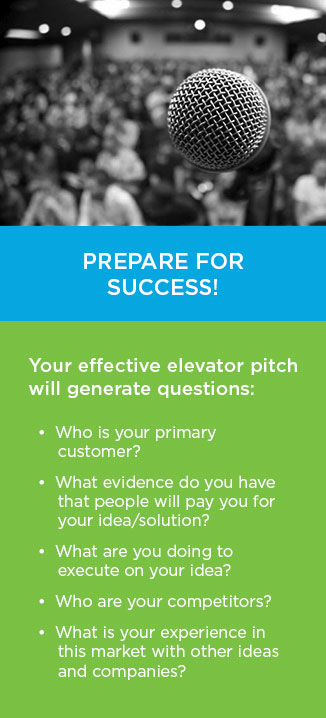Make Your Elevator Go to the Top
This morning when I Googled “elevator pitch,” I got 2.3 million hits.
I’m actually surprised it wasn’t more.
If there are more ubiquitous term in entrepreneurial playbook than “elevator pitch,” there aren’t many.
And almost as ubiquitous as the words, are the places that an entrepreneur might be giving an elevator pitch—and just for the record, most of them are not an elevator.
The environment could be anywhere, a chance encounter or a shared conversation. It could be a planned presentation, a group discussion at a networking event, a reunion (school, family, or otherwise), or on an airplane or a bus. It could be with an investor or your Aunt Molly.
It could be on the phone where there are no body language clues, just tone and silence to go on. It could be two minutes in front of an angel group.
At Rev1 we hear dozens and dozens of elevator pitches every week. Here are 5 tips to make yours outstanding.
-
Your elevator pitch is your audio logo, a vital part of your brand.
It really does start with a line or two. You want to grab attention, educate quickly, and entice. Be excited (but not manic) about what you are saying all for the purpose of continuing the conversation. Balance being confident with being aware of your surroundings and the discussion that is already going on.
The worst possible approach is to try and convey a message without regard for how your audience is reacting. We’re all been stuck in situations with a person who is going to say his or her spiel, regardless. Don’t be the one who makes people roll their eyes and inch away. Instead, be the entrepreneur who focuses on your listeners’ needs and interests—the entrepreneur who gets people to ask questions.
-
Versatility is the key.
Have two to three (or more) versions of your elevator pitch ready to roll, pitches that you’ve practiced and are so comfortable with that you can make minor changes on the fly. Develop one main 20-30 second elevator pitch, and then other 30-second lines that you can use depending on whether you are talking to an investor, partner, customer, employee, the media, or some other audience.
The direction of your elevator pitch is consistent—what the company does, the problems your solution solves, but your message to each audience needs to use slightly different words so they can hear what they are listening for.
You want your listener’s response to be, how can I learn more? And you want to be prepared with answers.
-
Be reflective after each elevator pitch.
A good entrepreneur examines each “elevator pitch” exchange, both during and after. Often entrepreneurs are so eager to get their message across that they don’t take the time to observe what they are saying and how it’s being received.
Decide in advance that you are going to evaluate yourself. If you have a partner or mentor observing, invite their feedback. We are seldom as honest with ourselves as we need to be.
The main thing to remember about an elevator pitch is that you aren’t going to make a sale with it. No one is going to pull out a checkbook. A great elevator pitch simply opens a door to a conversation, and maybe the next meeting.

